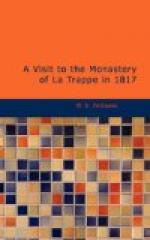At the hour of their first repast, I again attended Frere Charle to the eating-room, where nearly the same forms were observed as at their evening-meal; a small basin of boiled cabbage, two raw carrots, and a small piece of black bread, with a jug of water, constituted their solitary meal. A Monk, during the whole time, read sentences from Scripture; and a small hand-bell filled up the intervals of his silence, and proclaimed a cessation from eating, or movement of any sort. Over the door of the Refectory I observed the following inscription in Latin:—“Better is a dinner of herbs, where love is, than a stalled ox, and hatred therewith”.
Frere Charle invited me to partake of the frugal fare of his order. He said, “You will forgive my laying before you a vegetable repast; it is all that I have in my power to offer you, but you will confer a pleasure by accepting it”. It was impossible to refuse, for I felt I should appear ungrateful after the attentions that had been shown me, if I had. Frere Charle conducted me into an apartment, in which I was gratified to observe a well executed portrait of the Abbe de Rance, which, at the destruction of the Monastery, had been preserved by the surgeon of the ancient fraternity, who continued to reside there until the period of his death, four or five years since. This person was greatly respected by all the people round the country, and resorted to by all who sought relief either from sickness or misery!—Had the other brothers followed his example of remaining, in all probability their Convent might have been spared, for the accumulation of wealth could not be laid to their charge; and as their monastic vows obliged them to remain within the Monastery, they were most unlikely to incur the suspicion of any political intrigues.—How indeed could men, whose whole existence was passed in solitude and penance, and who never conversed even among themselves, have been dangerous to those turbulent spirits who had overturned the government and all the religious institutions of their country!
In the portrait, the Abbe is dressed in the habit of the order, a white gown and hood, and sitting with a book before him, in which he appears to be writing; on the same table, before him, are a crucifix and a skull. The following inscription is painted in one corner by the artist:
“ARM’D. LE BOUTTHILLIER DE RANCE. S’R SCAUANT. et celebre Abbe Reformateur De La Trappe. Mort en 1700. a pres de 77 ans, et de 40 ans de la plus austere penitence”.
The Monastery of La Trappe is one of the most ancient Abbeys of the order of Benedictins: it was established under the pontificate of Innocent the Second, during the reign of Louis VII. in the year 1140, by Rotrou, the second Count of Perche, and is said to have been built to accomplish a vow, made in the peril of shipwreck. In commemoration of this circumstance, the roof was made in the shape of the bottom of a ship inverted. It was founded under the auspices of Saint Bernard, the first Abbot of Clairvaux, the celebrated preacher in favour of the Crusades. Many ages, however, had elapsed, since its first institution, when the Father Abbot de Rance, the celebrated reformer of his time, determined to become a member, whose singular history and conversion was the subject of a poem by Monsieur Barthe.




